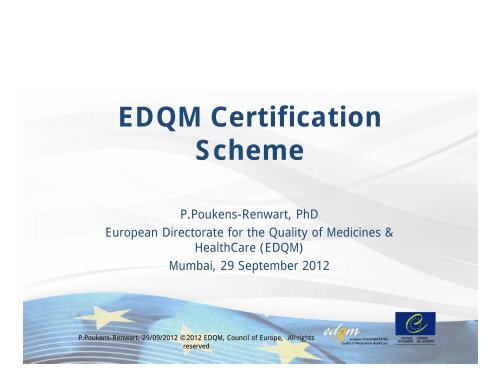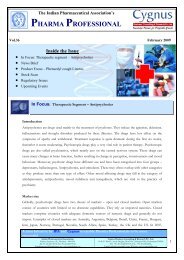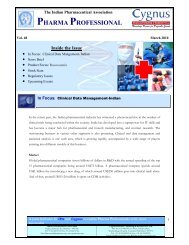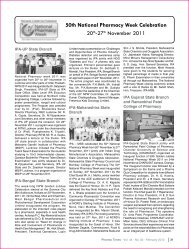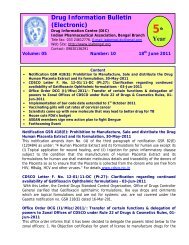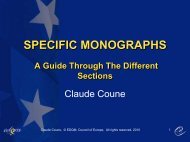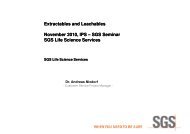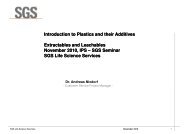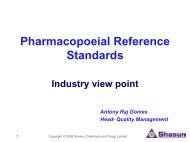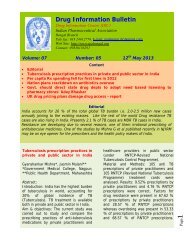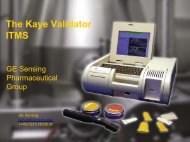Dr. Pascale Poukens - Renwart - EDQM certification scheme
Dr. Pascale Poukens - Renwart - EDQM certification scheme
Dr. Pascale Poukens - Renwart - EDQM certification scheme
You also want an ePaper? Increase the reach of your titles
YUMPU automatically turns print PDFs into web optimized ePapers that Google loves.
<strong>EDQM</strong> Certification<br />
Scheme<br />
P.<strong>Poukens</strong>-<strong>Renwart</strong>, PhD<br />
European Directorate for the Quality of Medicines &<br />
HealthCare (<strong>EDQM</strong>)<br />
Mumbai, 29 September 2012<br />
P.<strong>Poukens</strong>-<strong>Renwart</strong>, 29/09/2012 ©2012 <strong>EDQM</strong>, Council of Europe, All rights<br />
reserved
Summary<br />
•Regulatory background<br />
•Difference between CEP and ASMF<br />
•The Certification procedure role<br />
•The CEPs<br />
•Key figures<br />
•How to communicate with <strong>EDQM</strong>?<br />
P.<strong>Poukens</strong>-<strong>Renwart</strong>, 29/09/2012 ©2012 <strong>EDQM</strong>, Council of Europe, All rights<br />
reserved
Regulatory background<br />
For active substances in marketing authorization<br />
applications:<br />
Directives 2001/83/EC, 2001/82/EC, 2003/63/EC<br />
as amended, and the various quality guidelines<br />
give options on how to fulfil the same<br />
requirements<br />
P.<strong>Poukens</strong>-<strong>Renwart</strong>, 29/09/2012 ©2012 <strong>EDQM</strong>, Council of Europe, All rights reserved
Directive 2003/63/EC<br />
• In cases where a specification contained in a European<br />
Pharmacopeia monograph might be insufficient to<br />
ensure the quality of the substance (new impurities),<br />
the competent authorities may request more<br />
appropriate specifications from the marketing<br />
authorisation holder<br />
• The competent authorities shall inform the authorities<br />
responsible for the pharmacopoeia in question. The<br />
marketing authorisation holder shall provide the<br />
authorities of that pharmacopoeia with the details of the<br />
alleged insufficiency and the additional specifications<br />
applied<br />
P.<strong>Poukens</strong>-<strong>Renwart</strong>, 29/09/2012 ©2012 <strong>EDQM</strong>, Council of Europe, All rights reserved
Rationale for the use of CEPs<br />
• Directive 2003/63/EC: Where the active substance<br />
and/or raw and starting material or excipient(s) are<br />
the subject of a monograph of the EP, the applicant<br />
can apply for a certificate of suitability that, where<br />
granted by the <strong>EDQM</strong>, shall be presented in the<br />
relevant section of the Module. Those certificates of<br />
suitability …are deemed to replace the relevant data of<br />
the corresponding sections described in the Module…<br />
• “Summary of requirements for active substances in the<br />
quality part of the dossier” describes how to<br />
communicate the information on the active substance<br />
(AS) to European authorities<br />
P.<strong>Poukens</strong>-<strong>Renwart</strong>, 29/09/2012 ©2012 <strong>EDQM</strong>, Council of Europe, All rights reserved
NfG CHMP/QWP/297/97 rev. 1 corr<br />
« Summary of requirements for active<br />
substances in the quality part of the dossier »<br />
Gives three basic choices for providing<br />
information regarding the active substance:<br />
2.1. Certificate of suitability<br />
2.2. Active Substance Master File (ASMF)<br />
2.3. Full details of manufacture in Marketing<br />
Authorisation Application<br />
The information required is the same<br />
regardless of the procedure selected<br />
P.<strong>Poukens</strong>-<strong>Renwart</strong>, 29/09/2012 ©2012 <strong>EDQM</strong>, Council of Europe, All rights reserved
NfG CHMP/QWP/297/97 rev. 1 corr.<br />
« Summary of requirements for active<br />
substances in the quality part of the dossier »<br />
2.1 Certificate of suitability<br />
• requires Ph. Eur. Monograph (specific or TSE)<br />
• used for “existing” substances<br />
• “where applicable, option 2.1 has the advantage of<br />
generally avoiding any subsequent reassessment”<br />
2.2 Active substance Master File (ASMF)<br />
2.3 Full details of manufacture in marketing<br />
authorisation application<br />
• both procedures do not require Ph. Eur. Monograph<br />
• can be used for “new” and “existing” substances<br />
P.<strong>Poukens</strong>-<strong>Renwart</strong>, 29/09/2012 ©2012 <strong>EDQM</strong>, Council of Europe, All rights reserved
Differences between CEP & ASMF<br />
Scope:<br />
• CEP: pharmacopoeial substances only,<br />
-> active substances or excipients<br />
-> any substance with TSE risk<br />
• ASMF: active substances only,<br />
-> new or pharmacopoeial<br />
P.<strong>Poukens</strong>-<strong>Renwart</strong>, 29/09/2012 ©2012 <strong>EDQM</strong>, Council of Europe, All rights reserved
Comparison between CEP & ASMF procedures<br />
Dossier<br />
Additional<br />
data<br />
Link with a<br />
medicinal<br />
product<br />
Evaluation<br />
CEP procedure<br />
Full dossier sent directly by AS<br />
manufacturer to <strong>EDQM</strong>, it will be the<br />
holder of the CEP<br />
Independent from marketing<br />
authorization applications<br />
Single evaluation centralised at <strong>EDQM</strong><br />
by assessors nominated by National<br />
Authorities / Certification Steering<br />
Committee<br />
ASMF system<br />
‐ Full dossier sent by AS manufacturer to<br />
National Authorities<br />
‐ Applicant’s part sent by AS manufacturer<br />
to MA applicant or holder of medicinal<br />
product<br />
‐ Letter of access (to be sent by AS<br />
manufacturer)<br />
In the context of a specific marketing<br />
authorization application or variation for<br />
medicinal products<br />
Assessment of ASMF by each national<br />
authority in the context of assessing a<br />
specific marketing authorization application<br />
or variation for medicinal products<br />
Deliverable<br />
Certificate including annexes<br />
(additional tests to be performed)<br />
granted to manufacturer who supplies<br />
a copy of it to customers (a MA holder<br />
using the AS)<br />
A Marketing Authorisation for the medicinal<br />
product using this particular AS<br />
P.<strong>Poukens</strong>-<strong>Renwart</strong>, 29/09/2012 ©2012 <strong>EDQM</strong>, Council of Europe, All rights reserved
The CEP procedure role<br />
• To demonstrate that the quality of a substance<br />
is controlled by the Ph. Eur. monograph +<br />
additional tests if needed (“Chemical CEP” or<br />
“Herbal CEP”)<br />
• To guarantee compliance with the Ph. Eur.<br />
general monograph on Products with TSE risk<br />
(« TSE CEP »)<br />
P.<strong>Poukens</strong>-<strong>Renwart</strong>, 29/09/2012 ©2012 <strong>EDQM</strong>, Council of Europe, All rights reserved
The CEP provides<br />
• Single centralised evaluation No duplication<br />
of work, avoids any potential divergences in<br />
assessments<br />
• Confidentiality of data :<br />
– Application submitted directly to <strong>EDQM</strong> by the<br />
applicant<br />
– Dossiers stored and assessed at the <strong>EDQM</strong><br />
– Independent of any marketing authorisation<br />
application<br />
P.<strong>Poukens</strong>-<strong>Renwart</strong>, 29/09/2012 ©2012 <strong>EDQM</strong>, Council of Europe, All rights reserved
The CEP provides (cont)<br />
• Easier management of marketing authorisation<br />
applications and variations - replaces main part<br />
of 3.2.S<br />
• CEP accepted in all Ph. Eur. countries (36) +<br />
others (eg. Canada, Australia, New-Zealand etc.)<br />
Saving of time and costs for Industry and<br />
Licensing Authorities<br />
P.<strong>Poukens</strong>-<strong>Renwart</strong>, 29/09/2012 ©2012 <strong>EDQM</strong>, Council of Europe, All rights reserved
Governing document for the<br />
Certification procedure<br />
• Resolution AP-CSP (07) 1 adopted by the Public<br />
Health Committee of the Council of Europe<br />
• Describes the process for the procedure<br />
• Available on the <strong>EDQM</strong> website (www.edqm.eu)<br />
P.<strong>Poukens</strong>-<strong>Renwart</strong>, 29/09/2012 ©2012 <strong>EDQM</strong>, Council of Europe, All rights reserved
Scope of the CEP procedure<br />
• Substances described in monographs in the Ph. Eur.<br />
(Active substances, excipients, herbal drugs / herbal<br />
preparations)<br />
→ “Chemical” or “Herbal” CEP<br />
• Products with risk of TSE (SM, intermediates,<br />
reagents,..)<br />
→ “TSE” CEP<br />
• Substances described in monographs in PhEur and<br />
with TSE risk → “Double” CEP<br />
• Open to any manufacturer regardless of<br />
geographical origin<br />
P.<strong>Poukens</strong>-<strong>Renwart</strong>, 29/09/2012 ©2012 <strong>EDQM</strong>, Council of Europe, All rights reserved
Out of Scope of the Certification<br />
procedure<br />
• Substances not included in Ph. Eur (other than TSE<br />
substances)<br />
• Human tissues derivatives, blood derivatives, vaccines<br />
• Finished products<br />
• Products extracted from animal tissues:<br />
– List published by CMD(h)-2007<br />
http://www.hma.eu/uploads/media/070618.pdf<br />
– Ex. heparins, aprotinin,….<br />
– No new application accepted (chemical evaluation)<br />
since end 2009<br />
– Still possible for a TSE CEP<br />
P.<strong>Poukens</strong>-<strong>Renwart</strong>, 29/09/2012 ©2012 <strong>EDQM</strong>, Council of Europe, All rights reserved
Certification: Organisation<br />
• Steering Committee<br />
• Technical Advisory Boards (TAB)<br />
Chemical<br />
TSE<br />
Herbals<br />
• Assessors<br />
• Certification Division<br />
P.<strong>Poukens</strong>-<strong>Renwart</strong>, 29/09/2012 ©2012 <strong>EDQM</strong>, Council of Europe, All rights reserved
Steering Committee<br />
• Representatives of main regulatory bodies (14<br />
members from EMA WP, EU Commission, Ph. Eur<br />
Commission, Non-EU licensing authorities,...)<br />
• Monitoring Certification procedure<br />
• Appointment of assessors<br />
• Appointment of Technical Advisory Boards (TABs) and<br />
their Chairperson<br />
• Policy adoption<br />
• Review and comment on issues raised by TABs<br />
• Co-ordination of issues between the represented<br />
parties<br />
P.<strong>Poukens</strong>-<strong>Renwart</strong>, 29/09/2012 ©2012 <strong>EDQM</strong>, Council of Europe, All rights reserved
Technical Advisory Boards (TABs)<br />
• Consist of experienced assessors involved in the<br />
CEP procedure for a substantial time<br />
Role:<br />
• To take decisions on technical matter<br />
• To assist assessors in case of doubt or<br />
disagreement<br />
• To prepare technical guidance<br />
• To identify technical/scientific problems and seek<br />
advice of SC<br />
P.<strong>Poukens</strong>-<strong>Renwart</strong>, 29/09/2012 ©2012 <strong>EDQM</strong>, Council of Europe, All rights reserved
Assessors<br />
– Are proposed by national authorities and<br />
approved by the Steering Committee. They<br />
come from the Licensing Authorities and are<br />
skilled in the relevant domain (chemical<br />
evaluation, TSE risk, herbal products,<br />
toxicologists)<br />
– Come regularly to <strong>EDQM</strong> premises for the<br />
evaluation of dossiers<br />
– They are also <strong>EDQM</strong> assessors who are<br />
appointed by the Steering Committee.<br />
P.<strong>Poukens</strong>-<strong>Renwart</strong>, 29/09/2012 ©2012 <strong>EDQM</strong>, Council of Europe, All rights reserved
Certification Division<br />
• <strong>EDQM</strong> scientific and administrative staff<br />
• Role : execution of the procedure and<br />
co-ordination<br />
P.<strong>Poukens</strong>-<strong>Renwart</strong>, 29/09/2012 ©2012 <strong>EDQM</strong>, Council of Europe, All rights reserved
How it works:<br />
Application<br />
To be updated :<br />
‐ at any change (notification,<br />
minor/major)<br />
‐ after 5 years (renewal)<br />
Request for inspection<br />
Validation at receipt<br />
Request for add info<br />
Revision of monograph<br />
Evaluation (2 assessors)<br />
+ TAB if necessary<br />
Refusal<br />
Transfer to the Ph. Eur.<br />
experts group<br />
CEP granted<br />
Possibility<br />
of hearing<br />
Info to<br />
licensing authorities<br />
P.<strong>Poukens</strong>-<strong>Renwart</strong>, 29/09/2012 ©2012 <strong>EDQM</strong>, Council of Europe, All rights<br />
reserved
How long does it take?<br />
• Applicant notified by <strong>EDQM</strong> on the assessment<br />
conclusion within 5 months of receipt of the<br />
new dossier<br />
• If additional information is requested, responses<br />
from applicant expected within 6 months<br />
• Responses assessed within 4 months<br />
• Strict procedure applied - only one request for<br />
additional information<br />
P.<strong>Poukens</strong>‐<strong>Renwart</strong>, 29/09/2012 ©2012 <strong>EDQM</strong>, Council of Europe, All rights reserved<br />
22
How long does it take?<br />
• Our performance figures are published in our<br />
monthly report on our website:<br />
• Also list other things which have changed in the<br />
month (suspensions etc.)<br />
P.<strong>Poukens</strong>‐<strong>Renwart</strong>, 29/09/2012 ©2012 <strong>EDQM</strong>, Council of Europe, All rights reserved<br />
23
How to apply for a CEP<br />
• Application form (for new application)<br />
www.edqm.eu<br />
– Contains tables to be filled in, statements and<br />
declarations to be signed<br />
!! Updated application form to be used for any<br />
application submitted from 1 September 2012<br />
(declaration related to sharing of reports with<br />
authorities, all sites + roles to be listed, re-test<br />
period, etc)<br />
P.<strong>Poukens</strong>‐<strong>Renwart</strong>, 29/09/2012 ©2012 <strong>EDQM</strong>, Council of Europe, All rights reserved<br />
24
How to apply for a CEP<br />
• Dossier in English preferably (or French); 1<br />
copy;<br />
Content in compliance with:<br />
- Content of the Dossier for Chemical CEP :<br />
comparable to ASMF or 3.2.S of CTD<br />
- For TSE risk CEP: requirements from Ph Eur<br />
general text, 5.2.8 (=EU nfg)<br />
- Content of the dossier for herbal drugs/herbal<br />
drug preparations<br />
P.<strong>Poukens</strong>-<strong>Renwart</strong>, 29/09/2012 ©2012 <strong>EDQM</strong>, Council of Europe, All rights reserved
How to apply for a CEP<br />
• Quality Overall Summary using the template<br />
available on the <strong>EDQM</strong> website<br />
• Fee: 3000 Euros<br />
• Electronic submissions encouraged<br />
(eCTD, NeeS, pdf)<br />
P.<strong>Poukens</strong>‐<strong>Renwart</strong>, 29/09/2012 ©2012 <strong>EDQM</strong>, Council of Europe, All rights reserved<br />
26
A CEP looks like:<br />
P.<strong>Poukens</strong>-<strong>Renwart</strong>, 29/09/2012 ©2012 <strong>EDQM</strong>, Council of Europe, All rights reserved
Declaration of Access<br />
P.<strong>Poukens</strong>-<strong>Renwart</strong>, 29/09/2012 ©2012 <strong>EDQM</strong>, Council of Europe, All rights reserved
All CEPs specify<br />
• Unique Reference number<br />
(e.g. R0-CEP 2009-001-Rev01)<br />
• Title: clear definition of the substance<br />
+ grade when necessary (e.g.. micronised, sterile,…)<br />
• Holder + manufacturing site(s)<br />
• Monograph(s) concerned<br />
• Starting validity date<br />
• Line numbering and annex details if appropriate<br />
• Packaging material (for recent CEPs)<br />
• Use or non-use of materials of animal or human origin<br />
P.<strong>Poukens</strong>-<strong>Renwart</strong>, 29/09/2012 ©2012 <strong>EDQM</strong>, Council of Europe, All rights reserved
And as necessary<br />
• Additional impurities/Solvents/Catalysts<br />
– With limits and methods<br />
• Characterisation of the grade<br />
– With limits and methods<br />
• Tests of the monograph which can be<br />
omitted<br />
• Re-test period<br />
– With storage conditions + packaging material<br />
P.<strong>Poukens</strong>-<strong>Renwart</strong>, 29/09/2012 ©2012 <strong>EDQM</strong>, Council of Europe, All rights reserved
And for a TSE certificate<br />
• Country(ies) of origin of animals<br />
• Animal and nature of tissue(s) used<br />
• Manufacturing process applied (when<br />
relevant, e.g. gelatins)<br />
P.<strong>Poukens</strong>-<strong>Renwart</strong>, 29/09/2012 ©2012 <strong>EDQM</strong>, Council of Europe, All rights reserved
The chemical certificate of<br />
suitability :<br />
• Certifies that the quality of a given substance<br />
can be suitably controlled by the Ph. Eur.<br />
monograph<br />
• - with additions if necessary (stated on the CEP)<br />
• It DOES NOT replace a certificate of analysis<br />
• It IS NOT a GMP certificate<br />
P.<strong>Poukens</strong>-<strong>Renwart</strong>, 29/09/2012 ©2012 <strong>EDQM</strong>, Council of Europe, All rights reserved
The TSE certificate of suitability:<br />
• Certifies that the substance complies with the<br />
EMEA NfG on minimising the TSE risk<br />
• It DOES NOT certify that the quality of the<br />
substance can be suitably controlled by the<br />
Ph.Eur monograph<br />
• It IS NOT a certificate of analysis<br />
• It IS NOT a GMP certificate<br />
P.<strong>Poukens</strong>-<strong>Renwart</strong>, 29/09/2012 ©2012 <strong>EDQM</strong>, Council of Europe, All rights reserved
When using a CEP, what should be<br />
addressed at the level of the MAA ?<br />
• In addition to supplying a copy of the full CEP<br />
including annexes, some items may need to be<br />
addressed in the marketing authorization application<br />
(MAA).<br />
• <strong>EDQM</strong> assessment is performed taking into account<br />
the general use of the substance.<br />
Specific requirements for a drug product<br />
should be addressed at the level of the MAA<br />
P.<strong>Poukens</strong>-<strong>Renwart</strong>, 29/09/2012 ©2012 <strong>EDQM</strong>, Council of Europe, All rights reserved
What should be addressed at the<br />
level of the MAA ?<br />
– Stability if no re-test period mentioned on the CEP<br />
(unless the MA applicant has committed to test<br />
the substance immediately prior to use)<br />
– All data relating to physico-chemical characteristics<br />
(e.g. particle size) if no grade claimed, or if there<br />
are particular requirements of the drug product<br />
– Viral safety if material of animal origin is used in the<br />
manufacture<br />
P.<strong>Poukens</strong>-<strong>Renwart</strong>, 29/09/2012 ©2012 <strong>EDQM</strong>, Council of Europe, All rights reserved
Revisions of a CEP<br />
Based on current EU Regulation on<br />
Variations to Marketing Applications<br />
Specific guidelines for revisions of CEPs:<br />
• Guideline on requirements for revision / renewal<br />
of CEPs<br />
• Procedures for management of revision / renewal<br />
of CEPs<br />
→ Available on the <strong>EDQM</strong> website (last version<br />
implemented on 1 March 2010)<br />
P.<strong>Poukens</strong>-<strong>Renwart</strong>, 29/09/2012 ©2012 <strong>EDQM</strong>, Council of Europe, All rights reserved
Key figures<br />
• > 5000 CEP applications received<br />
• > 3400 valid CEPs<br />
• 960 sites from 56 countries covered<br />
These numbers change frequently as new<br />
applications are received and existing CEPs are<br />
revised daily.<br />
P.<strong>Poukens</strong>-<strong>Renwart</strong>, 29/09/2012 ©2012 <strong>EDQM</strong>, Council of Europe, All rights reserved
Repartition of manufacturers (2011)<br />
1. India 214 sites<br />
2. China 202 sites<br />
3. Italy 90 sites<br />
4. USA 58 sites<br />
5. Germany 57 sites<br />
P.<strong>Poukens</strong>-<strong>Renwart</strong>, 29/09/2012 ©2012 <strong>EDQM</strong>, Council of Europe, All rights reserved
Communication with <strong>EDQM</strong><br />
• <strong>EDQM</strong> Website (7 pages: procedure,<br />
guidelines, documents, news…):<br />
www.edqm.eu<br />
P.<strong>Poukens</strong>-<strong>Renwart</strong>, 29/09/2012 ©2012 <strong>EDQM</strong>, Council of Europe, All rights reserved
Communication with DCEP<br />
• A paper describing the ways to best<br />
communicate with <strong>EDQM</strong> is published<br />
on the <strong>EDQM</strong> web site:<br />
P.<strong>Poukens</strong>-<strong>Renwart</strong>, 29/09/2012 ©2012 <strong>EDQM</strong>, Council of Europe, All rights reserved
Is a CEP valid ?<br />
• www.edqm.eu<br />
Hints:<br />
To see all certificates, search for all<br />
certificate numbers containing CEP.<br />
In general you will get more hits with<br />
“contains” than “is exactly”.<br />
Spelling is important<br />
P.<strong>Poukens</strong>-<strong>Renwart</strong>, 29/09/2012 ©2012 <strong>EDQM</strong>, Council of Europe, All rights reserved
Is a CEP valid ?<br />
Holder name<br />
Full CEP number<br />
Issue date of the current CEP<br />
Status<br />
P.<strong>Poukens</strong>-<strong>Renwart</strong>, 29/09/2012 ©2012 <strong>EDQM</strong>, Council of Europe, All rights reserved
Communication with <strong>EDQM</strong><br />
• General questions on CEPs: Look at the FAQs<br />
and if necessary use <strong>EDQM</strong> Helpdesk<br />
P.<strong>Poukens</strong>-<strong>Renwart</strong>, 29/09/2012 ©2012 <strong>EDQM</strong>, Council of Europe, All rights reserved
Communication with <strong>EDQM</strong><br />
• For application specific queries: via the<br />
email address (included in our<br />
communication)<br />
• Technical Advice: to meet the <strong>EDQM</strong> staff<br />
and get advice about applications (fee)<br />
P.<strong>Poukens</strong>-<strong>Renwart</strong>, 29/09/2012 ©2012 <strong>EDQM</strong>, Council of Europe, All rights reserved
Thank you !<br />
P.<strong>Poukens</strong>-<strong>Renwart</strong>, 29/09/2012 ©2012 <strong>EDQM</strong>, Council of Europe, All rights<br />
reserved


